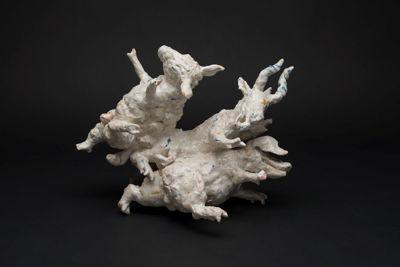Michael Flynn
Michael Flynn is a man of many parts, a man of many identities and manifestations. So it should not surprise that the idea of identity seems central in his work. You might even be forgiven for assuming that is to be expected of someone with a twin brother and born in Germany at the end of the war to Irish parents. And not long after settling in England—but with memorable holidays spent on a farm in rural Ireland. Confusing? No, that is just the innate Irishness of Flynn. Flynn attended art college but left to be a zoo keeper for a year. The close inter-relationship of animals and humans seems to be deeply imprinted on his psyche. Michael Flynn is a very urban person but his leering pigs and impossibly balanced figures capture a wild animal essence which flows throughout his oeuvre. He has traveled so widely and so often that it can almost be surmised that he has no fixed abode. Yet it is his studio in Cardiff, Wales which he considers his primary base. Flynn originally studied fine art in Birmingham in the 1960s but after a long gap, returned to studies in Cardiff as a mature student. He chose ceramics because he felt he needed a more structured discipline. He has always rejected the dominant academic tendency of vessel making as the ultimate statement in ceramics. Flynn is committed to both a fine art approach and the figurative work which has long been marginalized by ceramicists worried about its lack of integrity and associations with dainty porcelain figurines. He has taught and exhibited widely in Central Europe and considers it his second home. The story telling traditions, literature, and mythology of that part of the world feed his imagination (he is Irish after all). Underpinning it all is a European cultural heritage rooted in misbehaving of gods and satyrs. Flynn has never been tied down to specific techniques although his attachment to porcelain has been long standing., to achieve the contrast he wants, parts may sometimes be glued together, a practice anathema—even anarchic to most ceramicists. It is yet another of the ceramic rules that Flynn happily flaunts. The visual power of his work is created by the spontaneity of his free-hand modeling, provocative poses, and dynamic balancing of the figures. Figures are naked but often given significant props; their sexuality heightened by gesture and detail. The overall color is white with an occasional splash of some unexpected hue. But it is his touches of red that ignite unease. They almost seem accidental but they are not and add a frisson of devilment and danger. For some they may even go too far, but his figures insist on a visceral bodily response—emerging from the deep veins of stories and images that drill back through European culture to Gothic tales of Renaissance orgies and classical myths of men turned beast. Flynn glories in the play on religious and sexual imagery. Today Flynn is a major and profoundly influential figure in ceramic art. His work is exhibited in over forty museums worldwide.
Sort by
Display per page
Title: Celebration
Artist: Michael Flynn
A brace of multicultural myth and classical drama informs the work of sculptor Michael Flynn, who’s figural ceramic ‘Celebration’ is packed with density of information in form and surface arrangement. Each of the three creatures is carefully composed and balanced for the resulting jubilant and gravity-defying bearing, the porcelain modelled by hand for a rough and expressive finish that conforms with the sense of dance-like activity, then sparsely flecked with colour to accentuate tiny movement or arrangement within the larger drama.


